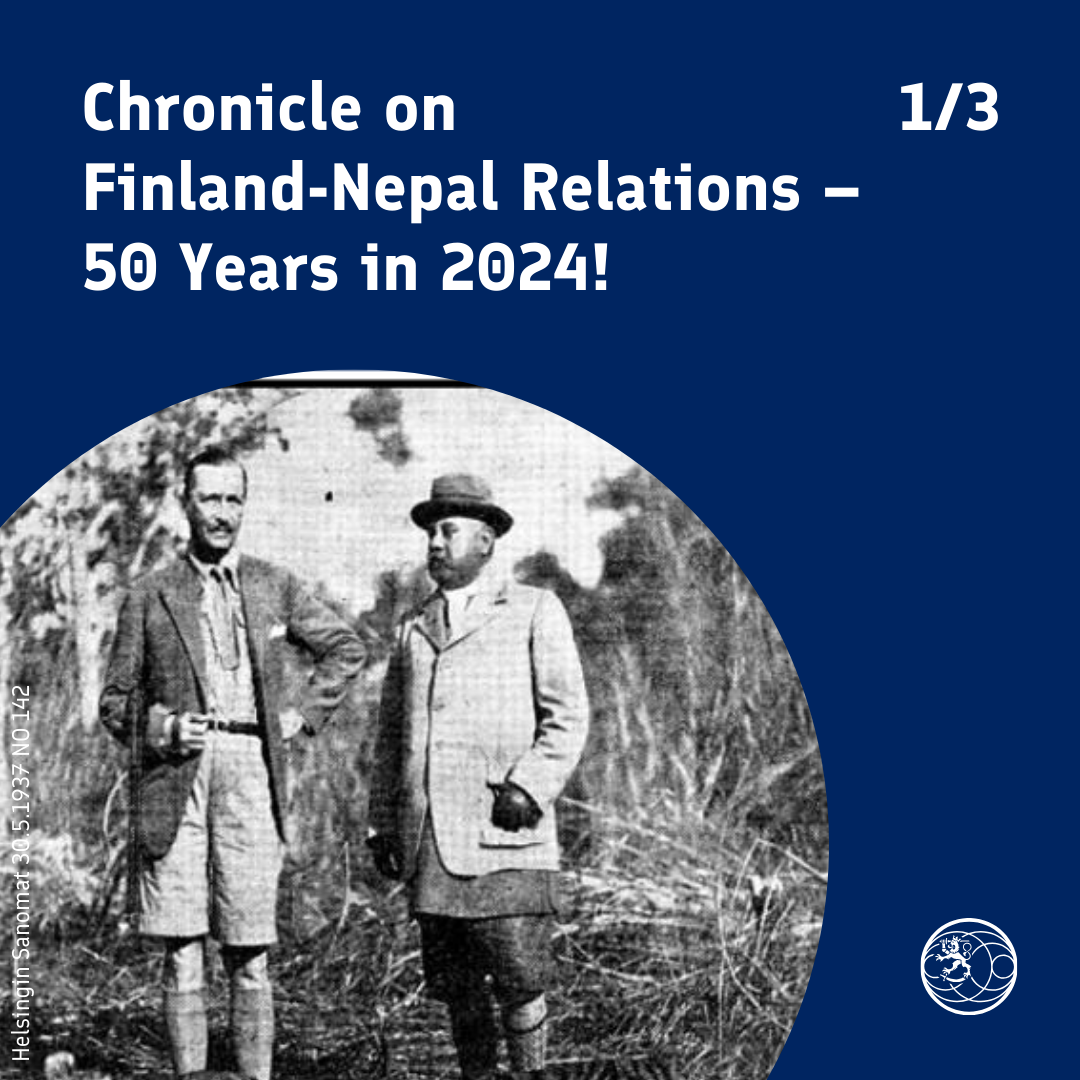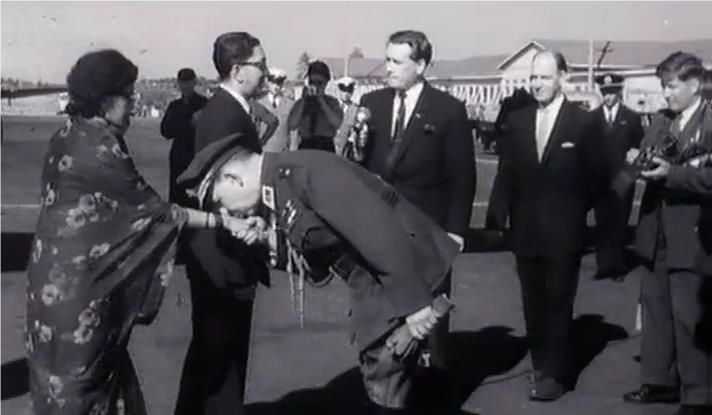Celebrating 50 Years of Diplomatic Ties: The History of Finland-Nepal Relations (Part 1/3)
For a long time, Nepal remained a distant and unfamiliar kingdom to Finland. This started to change in the early decades of 19th century when Finnish newspapers began publishing articles about the mighty Himalayas, Gurkha soldiers and Buddha’s birthplace. Later on, Finnish Marshal Mannerheim embarked on a rare visit to the mystical Nepal in 1937, a country largely closed off to outsiders at the time. Marshal’s visit paved way to Finland’s first Ambassadorial visit from New Delhi and correspondingly, a courtesy visit of the King and Queen of Nepal to Helsinki took place in 1958, gradually laying the foundation for developing relations.

Early stages of the relations: Finnish newspapers’ first reports on the distant Himalayan country
Finnish newspaper readers first encountered the distant kingdom of Nepal as early as 1816. At that time, reports covered the peace treaty signed between the British East India Company and the King of Nepal, which ended several years of conflict. In the 1840s, a Finnish newspaper covered the Prussian prince's extensive journey through Asia, including his visit to Kathmandu. Despite this, Nepal remained a distant and rather unknown country from Finland's perspective for many years.
In the early decades of the 20th century, Finnish newspaper readers were introduced to the mysterious kingdom largely inaccessible to Europeans; its Maharajas, the mighty Himalayan mountains including Mount Everest, the renowned Gurkha soldiers and their role in World War I, as well as the discovery of Buddha's birthplace.
Through these early reports, Finns gradually gained more knowledge of the Himalayan country, which still was regarded as far, far away mystical country at that time.

Field Marshal Mannerheim's trip to Nepal in 1937
Finnish newspapers devoted their biggest headlines and longest articles to Field Marshal Mannerheim's journey to India and Nepal. And understandably so – Carl Gustaf Emil Mannerheim is one the most significant characters in the history of independent Finland, a leader who charted the country’s course and a symbol of the Finnish defense against Soviet Union in Winter War of 1939-1940. Mannerheim was highly popular in Finland and on top of being the Commander-in-Chief and later the president of Finland; he was also an explorer and had already made several visits to Asia in the early years of the 20th century.

Following in January 1937, Marshal Mannerheim was welcomed in Nepal by Maharaja Juddha Shumsher Jung Bahadur Rana, who served as Nepal's Prime Minister from 1932 to 1945. The Maharaja was instrumental in establishing connections with European countries as Nepal slowly began to open up to the world. Diplomats from France, Belgium, the Netherlands, and Germany had already visited Kathmandu, and Juddha Shumsher's biography includes Finland's Marshal Mannerheim among the respected European dignitaries.
Mannerheim was pleased with his trip to India and Nepal. In a Finnish newspaper, he noted that he was especially delighted to have had the opportunity to visit Nepal: “A country that very few Europeans had been to and which was quite difficult to access... Only a few foreigners live there permanently... Its Gurkha people are known for their warlike nature, and Kipling has sung praises of their bravery... The country maintains friendly relations with England but is entirely independent”.
The memory of Mannerheim's visit lingered for many years. Fifteen years later, Finland's Ambassador to India in New Delhi wrote to the Ministry of Foreign Affairs in Helsinki, recalling how both the King of Nepal and the current Prime Minister fondly remembered the late Marshal of Finland's visit when they met him in New Delhi.
The Finnish Ambassador’s vacation trip to Kathmandu in 1951
The bilateral visits continued in 1950s. Finnish Ambassador (Envoy) to India, Hugo Valvanne, who began his tenure in New Delhi in 1949, also regularly reported on developments in South Asian countries. In late 1950, several of his reports focused on Nepal's internal politics and power struggles, a country which remained largely closed off to the outside world. However, in October 1951, Valvanne’s Nepalese counterpart, who was also the brother of Nepal's Prime Minister, organized a week-long vacation trip to Kathmandu for Valvanne and his family. The city left a lasting impression on Ambassador Valvanne: "The capital is located in a valley reminiscent of Switzerland or the Riviera, which is one of the most scenic in the world. The Himalayan mountains surround it on all sides. Mount Everest and four other peaks exceeding 8,000 meters are visible from there. The valley and mountain slopes are fertile and well-cultivated: everywhere there are rice, corn, or wheat fields and orchards."
Although the Finnish Ambassador was in Nepal on an unofficial visit, he was treated with significant respect. The Nepalese government provided several officials to assist him, a state guesthouse for accommodation, and a 12-man honor guard. The Valvanne family was also invited to a tea party hosted by the Prime Minister and an evening reception held by King Tribhuvan Bir Bikram Shah.
Ambassador Valvanne engaged in a lengthy discussion with the ruling Prime Minister, Mohan Shumsher Jung Bahadur Rana. The Prime Minister remarked on the similarities between Nepal and Finland, noting that both countries had large and powerful neighbors. Of course, Mohan Shumsher fondly recalled Marshal Mannerheim's visit to Nepal. They also briefly discussed the upcoming 1952 Olympics in Helsinki, with the Prime Minister highlighting the strength of Nepalese runners.
Hugo Valvanne's wife, Birgitte Valvanne, vividly recounted their visit to Kathmandu in her memoir, Salam Memsahib.
The Visit of the King and Queen of Nepal to Helsinki in 1958
In the spring of 1958, the Finnish Embassy in New Delhi notified the Ministry of Foreign Affairs in Helsinki that King Mahendra Bir Bikram Shah Dev of Nepal planned to make a state visit to the Soviet Union in early summer, followed by a journey westward. During this trip, the King expressed a desire to spend a couple of days in Helsinki, traveling with Queen Ratna Rajya Lakshmi Devi Shah on private visit. In response, the Ministry of Foreign Affairs began organizing the itinerary for their visit.

The Nepalese royal couple's plane touched down at Helsinki-Vantaa Airport on June 26, 1958. They were welcomed by the Chief of Protocol from the Ministry of Foreign Affairs, the Senior Adjutant to the President of the Republic, and around twenty journalists eager to cover the distinguished guests from afar. The visit was considered as exceptional and unique, as Nepal still remained a mystical, far-away country to Finland.
Although brief, the visit included a sightseeing tour of Helsinki, and President Kekkonen hosted a lunch for the royals at his summer residence in Kultaranta. Despite its short duration, the visit gave the Nepalese royals a glimpse of Finnish hospitality and the scenic beauty of Helsinki.
With these visits, the ties between Finland and Nepal started to form and the connection strengthen. In the next part of the chronicle, you will learn about the formation of diplomatic relations and the significant steps that paved the road for the establishment of bilateral development cooperation between Finland and Nepal.
Text: Jyrki Paloposki. Translation and editing: Petra Enbuske

